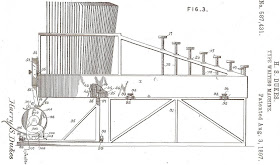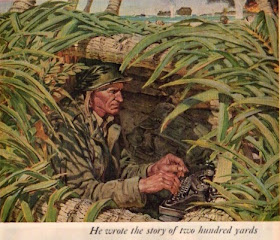AUGUST 3
THE DUKES TYPEWRITER
Let me hazard a guess:
“Almost the last word
in typewriter advance”
On this day in 1897, Harry S. Dukes, then of St Louis, was issued with the first two patents for a typewriter which, in 1909, British journalist and typewriter historian George Carl Mares would describe as having the potential to be “the last word in typewriter advance”.
The idea was a standard typewriter which could easily convert into a book-writing machine.
Dukes, born in Ohio in August 1867, had moved to Little Rock, Arkansas, by the time of his next round of typewriter patent applications. And there he had established the Dukes Typewriter Company, clearly planning to put his marvellous machine into production.
In Little Rock, Dukes and his wife shared their house with one William H. Clayton (born Arkansas, January 1867), who was described in the 1900 US census as a “brother” of the head of the household. Perhaps he was Dukes’ brother-in-law.
Anyway, Clayton had been dabbling in inventing since 1888, when he patented a sewing machine, and he and Dukes were to join forces in patenting a series of advances on the Dukes typewriter from 1901 until 1908.
Dukes was also issued for a patent for a “vertical-plane” typewriter in 1906 (below), and a “work holder attachment for a typewriter desk” in 1911.
Apart from improvements to the tabulation of the Dukes machine, Dukes and Clayton worked on the ribbon movement. It can be seen from Dukes’ specifications for his patents issued in 1897 that adjusting the ribbon to allow for “visible” writing was high on his agenda.
In his patent application, originally filed on February 2, 1895, Dukes described his objectives as, “to provide a simple, light, efficient and durable machine capable of adjustment to adapt it for either bookwork or for general writing”.
He said the main frame contained printing, inking and feeding mechanisms, “whereby when used in connection with stationary tracks or guides, it is adapted to move parallel with the lines of writing, and when mounted upon a stationary base and used in connection with a moving part or carriage adapted to travel parallel with the lines of writing it may be used for general work, such as letter-writing …”
He went on, “My invention further contemplates the provision of improved printing mechanism, in eluding ribbon-operating devices, whereby the line of writing is exposed at all times, except during the depression of a key, to enable the operator to view the same without displacing the machine or any part thereof.”
Dukes also sought “to provide improved letter-spacing mechanism … line-spacing mechanism and in combining therewith readily-accessible means for adjusting the carriage to bring the printing point at any desired space in the printing line.”
The Dukes typewriter, no doubt because it seems not to have gone into production, has largely been ignored by typewriter historians. However, in his The Writing Machine (1973), Michael Adler said this “dual-purpose machine [was] developed in 1908 by Dukes Typewriter Company of Little Rock.
“Of the downstroke group, it had a standard four-row keyboard and was designed to be used either as a book typewriter or, by coupling it with the optional carriages, as a regular machine.” Adler describes the vertical-plane machine as “interesting” and “novel”.
Mares, who incorrectly called this the “Duke typewriter”, said that by 1909 the machine was still “unmarketed”, although efforts were being made to raise capital in Britain.
Mares said the Dukes contained “extremely curious and high developed features” and had a “very complex” mechanism. He declared he had no doubt about the Dukes’ potential.
American war correspondent Ernest Taylor "Ernie" Pyle was born on the Sam Elder farm, just south-west of Dana, Indiana, on this day in 1900.
He was a roving correspondent for the Scripps Howard newspaper chain from 1935 until his death in combat during World War II.
He won the Pulitzer Prize in 1944. His articles, about the out-of-the-way places he visited and the people who lived there, were written in a folksy style, much like a personal letter to a friend. He enjoyed a following in some 300 newspapers.
In the above photograph of Pyle, right, he is sitting at a table on a balcony at the Grand Hotel in Paris with Associated Press journalist Hal Boyle on September 8, 1944.
Pyle studied journalism at Indiana University he became a cub reporter for the LaPorte Herald. Four months later, he was offered a $2.50-a-week raise to work for the Washington Daily News.
He wrote a daily aviation column for four years before becoming the paper’s managing editor.
Pyle loved to travel and succeeded in persuading Scripps Howard executives (the company that owned the Daily News) to allow him to be a roving reporter. The five-year odyssey that followed took Pyle and his wife, Jerry, across the United States and to Central and South America.
In 1940, with war raging in Europe, Pyle went to England to report on the Battle of Britain. By 1942, he was covering America’s involvement in the war. During the next three years, battle campaigns took him to North Africa, Italy and the Normandy Beaches in France.
In 1945, Pyle accepted what would be his last assignment — the Pacific theatre. He was killed by sniper fire on the island of Ie Shima on April 18, 1945.
English crime writer and Conservative Party life peer in the House of Lords, Phyllis Dorothy James (P.D.James, Baroness James of Holland Park) was born in Oxford on this day in 1920. She turns 91 today. James is most famous for a series of detective novels starring policeman and poet Adam Dalgliesh.
























The Dukes machine looks like another solution in search of a problem ... visibility would have been pretty poor, no?
ReplyDeleteErnie Pyle is the ultimate war writer (and typist).
Yes, I can't imagine how people could see through those shields. I've always stood up to use a Bar-Lock.
ReplyDeleteIsn't it interesting how many Pyle-with-typewriter images appear on posters etc?